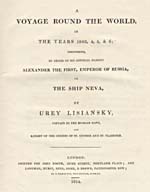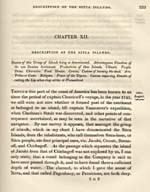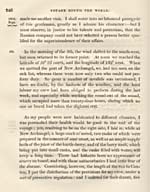|
|
RUSSIANS IN THE NORTH PACIFICVitus Jonassen Bering (1681 - 1741)
|

|
| Peter the Great Copyright/Source |
While the Europeans were looking for a passage to Asia through the Arctic Ocean or through the interior of the North American continent, the Russians were trying to find out if Siberia was linked to North America. In 1648, the Cossack Semyon Ivanovich Dezhnev conducted a first expedition which went around the point of Siberia and proved that the two continents were separate. But his report was buried in the archives and, when Tsar Peter the Great commanded Vitus Jonassen Bering and Aleksey Ilyich Chirikov to explore this region to find out if the two continents were linked, it was a new beginning and, consequently, it was called the 'first Kamchatka expedition'.
Vitus Jonassen Bering was born in Horsens, Denmark, in 1681. He had already visited India when he became a naval officer at the service of Imperial Russia in 1724. Promoted to first captain, he was charged with conducting the 'first' Kamchatka expedition in 1728. Before reaching Kamchatka, he had to cross more than 7 200 kilometres by land with 33 men, including lieutenant Aleksey Ilyich Chirikov. The voyage took three years. At Kamchatka, Bering built the Saint Gabriel, a ship on which he skirted the coast northwards and discovered a large island, which he named "Saint Lawrence". On August 15, 1728, he had gone far into the polar sea. Knowing the results of previous expeditions in northern Russia, he knew that, at the latitude that he had just reached, the two continents did not join. He returned without having seen the North American continent due to fog and clouds. In Saint Petersburg, many were not convinced that the continents were not linked and demanded more thorough research.
In 1732, Russia organized a large expedition that would set out in three directions: the first would skirt the shore of the Arctic Ocean in Siberia; the second would explore the shores of the Sea of Okhotsk and of Japan; and the third, under Bering's command, would sail along the shores of America to Mexico. Bering would claim the northwest coast of North America for Russia.
This last expedition left Kamchatka in June 1741, with Bering and Chirikov each on his own ship. On July 16, Bering saw Mount Saint Elias, in Alaska, and landed on Kayak Island. Chirikov also reached the coast of Alaska, only further south. Bering explored Kodiak Island, surveyed the Kenai peninsula and the Aleutian Islands and took possession of the coast in Russia's name. On the way back, in November, almost at Kamchatka, his ship foundered on one of the Commander Islands. Bering and 18 members of his crew died of scurvy during the winter. The others managed to build a bark and to survive.
As for Chirikov, in 1743, he returned to Saint Petersburg with precise information on the strait that separates Siberia from North America -- since named Bering Strait. He also brought back furs, which drew the attention of Russian merchants and brought them to North American shores. The places along which Bering and his lieutenants had moored their ships were later established as the boundary of present-day Alaska.
From 1785 to 1794, N. I. Billings and G. A. Sarychev travelled a route through northeast Asia, Bering Strait, the northwest coast of America and the Aleutian Islands. They brought back many artifacts produced by the peoples of these regions. But, at the beginning of the next century, Catherine of Russia commanded a voyage of exploration around the world to see whether or not it would be appropriate to supply Alaska entirely by sea rather than by the land route used by Billings and Sarychev, which crossed Russia all the way to the Sea of Okhotsk and Kamchatka.
To this end, in 1803, a lieutenant of the Russian navy, Urey Fyodorovich Lisiansky, accompanied commander Adam Ivan Ritter von Krusenstern. The two men left the Baltic Sea and rounded Cape Horn sailing all the way to Hawaii. From there, in 1804, Krusenstern headed for the coast of Siberia and Japan whereas Lisiansky sailed towards the establishments of the Russian-American Company in the Gulf of Alaska. At Sitka, he helped to re-establish the trading post destroyed by the Tlingit two years earlier. He then continued his voyage to the west and returned to Russia in 1806. The voyage's objective had been met -- the Alaskan trading posts could be re-supplied more easily by sea than through Siberia. This also improved Russia's position in the competition for the fur trade with China.
 |
 |
|
| Title page of Lisiansky's account of his 1803-1806 voyage Copyright/Source |
Page from Lisiansky's account of his 1803-1806 voyage Copyright/Source |
|
"Though this part of the coast of America has been known to us since the period of Captain Cheericoff's voyage, in the year 1741, we still were not sure whether it formed part of the continent or belonged to an island, till captain Vancouver's expedition, when Chatham's Strait was discovered, [...] By our survey it appears, that amongst the group of islands, which in my chart I have denominated the Sitca Islands, from the inhabitants, who call themselves Sitca-hans, [...]" (Lisiansky 1814, 235) |
 |
| Page from Lisiansky's account of his 1803-1806 voyage Copyright/Source |
|
For his crew's health: "[...] I laid in, while at New Archangel, a large stock of sorrel, two casks of which were prepared in the manner of sour crout, as well as an ample supply both of the juice of the hurtle-berry, and of the berry itself, which being put into small casks, and the casks filled with water, will keep a long time. There had hitherto been no appearance of scurvy on board, and with these antiscorbutics I had little fear of the disease." (Lisiansky 1814, 246) |
In Russia as elsewhere, the growing interest in natural history and ethnology brought about new research expeditions into the lands that had been explored in the previous century. Thus, in 1839, the Academy of Sciences of Russia sent ethnologist I. G. Voznesenskii to study the "primitive" populations of Alaska and to collect artifacts. This researcher, considered as the most important scientist in Russia, spent almost ten years in America and the results of his research surpassed all hopes. He brought back more than one thousand articles from the Inuit and from Native peoples from Alaska to California. His rigorous work methods and the notes that accompanied this collection made this an incomparable source of information for those who studied the ethnology of the west coast of North America.
From 1842 to 1844, Lavrentii Alekseevich Zagoskin, a lieutenant in the Russian navy, led an expedition to Alaska for the Russian American Company. He explored the Yukon and Kuskokwim rivers to find sites that would be favourable for building trading posts. Influenced by Voznesenskii, Zagoskin also brought back precious artifacts and descriptions of the Inuit and Athabasca populations. The publication of the account of his voyage, in 1847, led to his being considered the most important ethnographer of his time.
After its defeat in the Crimean War, Russia did not want to cede its Alaskan territories to Great Britain and so transferred them to the United States in 1867. This marked the end of Russian presence in North America. Russian explorers contributed to making known the west coast and its people, from Alaska to California, including present-day British Columbia.